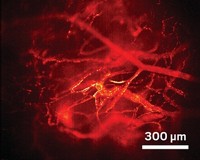Advertisement
Grab your lab coat. Let's get started
Welcome!
Welcome!
Create an account below to get 6 C&EN articles per month, receive newsletters and more - all free.
It seems this is your first time logging in online. Please enter the following information to continue.
As an ACS member you automatically get access to this site. All we need is few more details to create your reading experience.
Not you? Sign in with a different account.
Not you? Sign in with a different account.
ERROR 1
ERROR 1
ERROR 2
ERROR 2
ERROR 2
ERROR 2
ERROR 2
Password and Confirm password must match.
If you have an ACS member number, please enter it here so we can link this account to your membership. (optional)
ERROR 2
ACS values your privacy. By submitting your information, you are gaining access to C&EN and subscribing to our weekly newsletter. We use the information you provide to make your reading experience better, and we will never sell your data to third party members.
Nanomaterials
Gold nanoparticle–laden contact lenses adjust for color blindness
Lenses could be a convenient alternative to glasses that filter out problematic wavelengths to improve color perception
by Prachi Patel, special to C&EN
February 21, 2021
| A version of this story appeared in
Volume 99, Issue 6

New contact lenses that incorporate gold nanoparticles could one day offer a safe, convenient way for people with what’s commonly known as red-green color blindness to better distinguish those colors (ACS Nano 2021, DOI: 10.1021/acsnano.0c09657). In red-green color blindness—the most common type—reds can appear green, or vice versa, because light of certain wavelengths that fall between green and red triggers both sets of light receptors in the eyes. Some people with this type of color blindness wear tinted glasses or contact lenses that block these wavelengths and can help the wearer better distinguish colors, but some people don’t like the glasses’ tinted appearance, and organic dyes used in contacts could migrate out. Ahmed E. Salih and Haider Butt of Khalifa University and their colleagues made lenses containing gold nanoparticles in place of dyes. The nanoparticles are stable and absorb light at wavelengths that depend on the particles’ size. The researchers tested nanoparticles of three diameters in lenses, identifying two sizes that filtered the targeted wavelengths as effectively as widely used commercial corrective glasses. “We will soon test the biocompatibility of the lenses and if proven successful go to clinical trials,” Salih says.




Join the conversation
Contact the reporter
Submit a Letter to the Editor for publication
Engage with us on Twitter